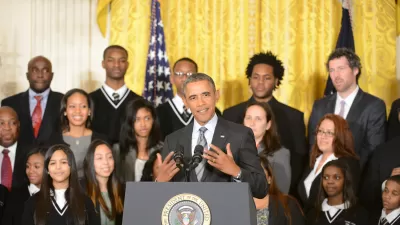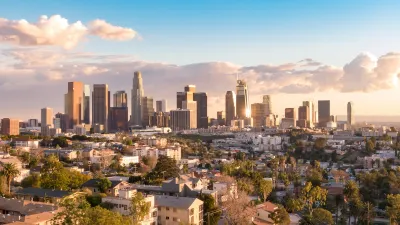South L.A.'s inclusion in the Promise Zones program marks a shift in the way the federal government measures poverty.

The Promise Zone program designates low-income areas with priority for competitive federal grants, as well as support in navigating the relevant agencies.
Nine new zones announced June 6 include neighborhoods in Nashville; Atlanta; San Diego; Florida; Puerto Rico; and, after two unsuccessful applications, South Los Angeles.
Several neighborhoods in Los Angeles were selected for the program when it launched in 2014. But South L.A. wasn’t picked—because despite its high levels of poverty, it didn’t meet federal criteria:
South L.A.’s own brand of poverty, marked by overcrowded housing, underemployment, and high rates of homelessness, apparently wasn’t scoring well when held up against expectations modeled on poverty seen in cities like Detroit (where high vacancy rates and high levels of unemployment are the norm).
Sahra Sulaiman describes in Streetsblog how the South Los Angeles Transit Empowerment Zone (SLATE-Z) collaborative invited HUD Secretary Julian Castro to L.A. "so he could see and hear for himself how the residents defined need"—and convinced the federal government to take varying manifestations of poverty into account.
Through their efforts, SLATE-Z created a network and an action plan that would benefit the community even if it didn't achieve Promise Zone status, Sulaiman notes.
The collaborative's ambitious long-range plan tackles workforce development, transit affordability, investment in local entrepreneurs and infrastructure, education, youth programs, and more.
FULL STORY: South L.A. Celebrates Slate-Z’s Promise Zone Designation; Prepares to Roll up Sleeves and Get to Work

Planetizen Federal Action Tracker
A weekly monitor of how Trump’s orders and actions are impacting planners and planning in America.

Maui's Vacation Rental Debate Turns Ugly
Verbal attacks, misinformation campaigns and fistfights plague a high-stakes debate to convert thousands of vacation rentals into long-term housing.

San Francisco Suspends Traffic Calming Amidst Record Deaths
Citing “a challenging fiscal landscape,” the city will cease the program on the heels of 42 traffic deaths, including 24 pedestrians.

Amtrak Rolls Out New Orleans to Alabama “Mardi Gras” Train
The new service will operate morning and evening departures between Mobile and New Orleans.

The Subversive Car-Free Guide to Trump's Great American Road Trip
Car-free ways to access Chicagoland’s best tourist attractions.

San Antonio and Austin are Fusing Into one Massive Megaregion
The region spanning the two central Texas cities is growing fast, posing challenges for local infrastructure and water supplies.
Urban Design for Planners 1: Software Tools
This six-course series explores essential urban design concepts using open source software and equips planners with the tools they need to participate fully in the urban design process.
Planning for Universal Design
Learn the tools for implementing Universal Design in planning regulations.
Heyer Gruel & Associates PA
JM Goldson LLC
Custer County Colorado
City of Camden Redevelopment Agency
City of Astoria
Transportation Research & Education Center (TREC) at Portland State University
Jefferson Parish Government
Camden Redevelopment Agency
City of Claremont




























